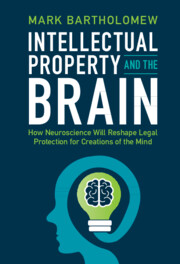 Intellectual Property and the Brain
Intellectual Property and the Brain from Part II - Understanding Audiences for Art and Advertising
Published online by Cambridge University Press: 14 July 2022
The current test for copyright infringement requires a court or jury to assess whether the parties’ works are “substantially similar” from the vantage point of the “ordinary observer.” Embedded within this test are several assumptions about audiences and art that neuroaesthetics—the study of the neural processes underlying aesthetic behavior—calls into question. To illustrate the disconnect between the law’s understanding of aesthetic appreciation and the reality of our reactions to works of art, the chapter explores a recent high-profile copyright matter involving the rock anthem “Stairway to Heaven.” Under current law, no effort is made to select jurors with the same listening or viewing tastes as the target audience for the original work—in this case, fans of classic rock. Nor can expert witnesses aid the jury’s understanding of that target audience. Instead, the assumption seems to be that we all appreciate works in the same indescribable way and one person’s reaction is as good as another. In truth, the basic biology of aesthetic reaction changes markedly depending on familiarity, experience, and even gender, contradicting copyright law’s one size-fits-all-approach.
To save this book to your Kindle, first ensure no-reply@cambridge.org is added to your Approved Personal Document E-mail List under your Personal Document Settings on the Manage Your Content and Devices page of your Amazon account. Then enter the ‘name’ part of your Kindle email address below. Find out more about saving to your Kindle.
Note you can select to save to either the @free.kindle.com or @kindle.com variations. ‘@free.kindle.com’ emails are free but can only be saved to your device when it is connected to wi-fi. ‘@kindle.com’ emails can be delivered even when you are not connected to wi-fi, but note that service fees apply.
Find out more about the Kindle Personal Document Service.
To save content items to your account, please confirm that you agree to abide by our usage policies. If this is the first time you use this feature, you will be asked to authorise Cambridge Core to connect with your account. Find out more about saving content to Dropbox.
To save content items to your account, please confirm that you agree to abide by our usage policies. If this is the first time you use this feature, you will be asked to authorise Cambridge Core to connect with your account. Find out more about saving content to Google Drive.